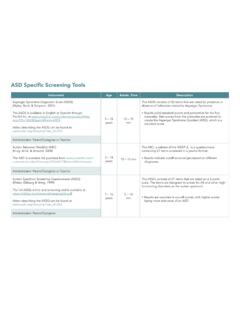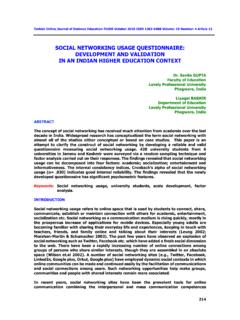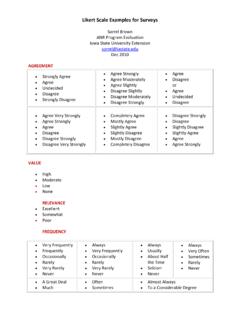Transcription of Mathematics Anxiety in Secondary School Students - ed
1 Mathematics Anxiety in Secondary School Students Lay Keow Ng National Institute of Education, Singapore The detrimental consequences of Mathematics Anxiety have repeatedly been evidenced empirically, yet little is known of its influence on Secondary School Students in Asia. This study thus examined its origins and impact on 294 Secondary Students in Singapore through interviews and surveys. Results revealed an average Anxiety level of 44% and a negative correlation with achievement. Of the top 5 situations that worried Students , 4 were test-related. Nonetheless, highly anxious Students continued to persevere and enjoy the subject. Mathematics Anxiety has consistently been proven to be debilitating on Mathematics achievement (Foong, 1987; Hembree, 1990; Ma, 1999; Preston, 2008).
2 Research has found it to be a learned behaviour, often arising early in one s educational experience and once it lays roots, its damaging effects will last through the School years. However, research on Asian Students is scarce as the majority of the studies are conducted in the United States (Ho et al., 2000). Moreover, most researchers had worked with high School (10th, 11th, and 12th graders) or college Students , rather than those in the lower grades (Wigfield & Meece, 1988). Hence, this study seeks to diagnose how fearful Secondary Students in Singapore are towards Mathematics , to examine its effects on their Mathematics performance, and to surface causes for their anxieties. Furthermore, it is interesting to investigate this phenomenon in Singapore, due to its unique education system and Asian culture.
3 As early as primary 4 (grade 4), Students are ability-banded by four subjects, including Mathematics and in primary 6, Mathematics again contributes to their Primary School Leaving Examination (PSLE) score (maximum aggregate of 300). This will then be used to stream Students into the express (EXP), normal academic (NA), or the normal technical (NT) course in Secondary schools, where the academically-abled Students will enter the express stream. At the end of Secondary 2 (grade 8), Students are ranked, with double merit given to their Mathematics results. Those who excel can then opt to take on advanced subjects or are offered more subjects. At Secondary 4 or 5, all Students will sit for the national examinations, where again, performance in Mathematics will determine their post- Secondary education paths.
4 As such, people in Singapore place great emphasis in academic performance, especially on Mathematics . As Ho et al. (2000) noted, this familial and societal stress placed on Students in Asian countries may produce a big number of Students who are extremely apprehensive about Mathematics . Hence, this study is to extend the efforts of researching on Mathematics Anxiety at this part of the world, and to address three questions. RQ1. How Mathematics -anxious are the Students in Secondary schools? RQ2. How significant is the relationship between the Mathematics achievement scores and the Mathematics Anxiety scores of the Students ? RQ3. What are some causes of Mathematics Anxiety in Secondary schools Students ?
5 Review of Literature Relevant research started in the 1970s, with Richardson and Suinn (1972, as cited in Preston, 2008, p. 230) as the first to define it as feelings of tension and Anxiety that interfere with the manipulation of numbers and the solving of mathematical problems in a wide variety of ordinary life and academic situations . Since then, others have continued In J. Dindyal, L. P. Cheng & S. F. Ng (Eds.), Mathematics education: Expanding horizons (Proceedings of the 35th annual conference of the Mathematics Education Research Group of Australasia). Singapore: MERGA. Mathematics Education Research Group of Australasia Inc. 2012 their efforts driven by research evidence that not only does Mathematics Anxiety inhibit one s ability to perform mathematically (Preston, 2008) but it is highly probable to have originated from classroom experiences too (Newstead, 1998).
6 Effects of Mathematics Anxiety on Mathematics Performance Mathematics Anxiety has been continually found to correlate negatively with Students Mathematics performance, with correlations ranging from to (Ho et al., 2000). Hembree (1990) analysed 151 relevant studies and reported an average correlation of for School Students whereas Ma (1999) s meta-analysis of 26 studies revealed a correlation of Similar results were also reported in Asia, like in China, Taiwan, and Singapore. Chiu and Henry (1990) conducted a study with 562 children from grade 4 to grade 8 and found the correlation between Anxiety and performance to be significant and negative. Interestingly, although three rating scales were used, only one was given to the entire sample.
7 Moreover, it was odd that semester grades were not collected from all the Students . In 1987, Foong carried out an exploratory study with 206 Secondary four express female Students from a single Singapore School . She reported that both Mathematics Anxiety and test Anxiety correlated negatively with Mathematics achievement but the relationship between Mathematics Anxiety and test Anxiety were positive and moderately strong. However, her research was conducted more than two decades ago and the instruments were all self-reported likert -scaled questionnaires that were unable to locate Students sources of Anxiety . Hence there exist this pertinent need to assess the Mathematics Anxiety level in Students and its association with mathematical performance.
8 Causes of Mathematics Anxiety The most frequently cited cause is the teacher, identified by Foong (1987) as the main source of Students tension. Highly-tensed Students dread presenting solutions in front of their classmates, viewing such situations as threatening (Ashcraft, 2002). Teachers who complained of insufficient instructional time might resort to preparing their Students for assessment rather than for understanding. This creates more tension when Students encounter unconventional problems or when the Mathematics becomes more advanced. Researchers also claimed that anxious teachers spend lesser time teaching Mathematics and are more likely to pass their phobia to their Students (Hembree, 1990; Ma, 1999).
9 Like teachers, parents could also pass their dread of Mathematics to their children (Hembree, 1990). Parents who are overly-concerned about results end up pressurizing their children, more so in Asian countries. Then there exists this myth that mathematical ability is inborn or hereditary (Godbey, 1997). Others believed that females are weaker in Mathematics even though researchers (Hembree, 1990; Ho et al., 2000) have found that though females tend to be more anxious, they are not necessarily weaker in Mathematics . Studies on the impact of teaching methods have been inconclusive. Norwood (1994, as cited in Preston, 2008) argued that traditional methods intensified Students anxieties though he found that college Students who were weak in Mathematics were more at ease with lecture-based teaching.
10 Newstead (1998) claimed that Students were more nervous working in groups and Preston added that as most teachers were recipients of direct instruction, they might not enjoy teaching in the constructivist way. Next, Mathematics has being viewed as an inherently difficult subject. Many Students are unable to see its practicality and teachers seldom attempt to make the connections. Foong (1987) explained that due to its cumulative and sequential nature, when Students missed out something along the way, it is likely that they may never fully comprehend it. 571 Furthermore, some Students have repeatedly performed poorly, leading to loss of self-confidence and increased tension. There are others who believe that Mathematics is a measure of their intelligence (Puteh, 2002) and are embarrassed by their inadequate performance.
















